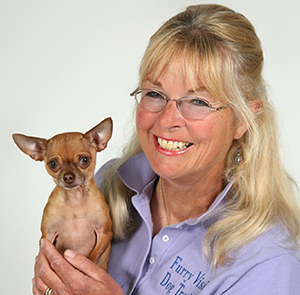 Catherine Clemente is a dog trainer in California and has been married for 40 years. In 2003, on her way to a dog show, with her dogs harnessed in the car, she was getting on the freeway when a coyote cut her off. “I swerved to miss him, my car spun out and slammed into the side of a mountain and rolled over.”
Catherine Clemente is a dog trainer in California and has been married for 40 years. In 2003, on her way to a dog show, with her dogs harnessed in the car, she was getting on the freeway when a coyote cut her off. “I swerved to miss him, my car spun out and slammed into the side of a mountain and rolled over.”
She lost consciousness and woke up to a stranger knocking on the the window. Her dogs were fine, and she thought she was too. Her husband was out of town, so she called her friend to come pick her up declining the highway patrol’s offer to call her an ambulance. Soon she began to have what she referred to as “visionary problems,” and her friend convinced her to go to the hospital.
After she had X-rays taken at the hospital, she was told her neck was broken and that she would either stop breathing or be permanently paralyzed. She contacted Dr. Hopkins who had successfully performed surgery (discectomy) on her the year before. Although he didn’t have privileges at the hospital she had been admitted to, his advice to her was to “make sure the hospital did an MRI or a CT before the final diagnosis.” She asked the doctors at the hospital, but they did neither.
Ultimately the doctors put her in a halo brace for three days during hospitalization. Once discharged, she was told to come back to the hospital every four days to have the screws in the brace tightened. On her second day home, she knew something wasn’t right. “My left hand started to go numb, and I had excruciating pain in my left scapula.” She called the doctor who had treated her at the hospital for four days, and never got a returned call.
She then called Dr. Hopkins and he immediately scheduled her for an MRI. After examining Mrs. Clemente in her halo brace, Dr. Hopkins said, “This is cruel and unjust punishment. You are not going to heal in that. You have fractured your cervical spine, ruptured ligaments and thus your neck is unstable, and you have a herniated disc.” He set her up for two corrective surgeries. The first surgery was an anterior neck surgery designed to remove the herniated disc, decompress her spinal cord and correct the alignment of her neck to normal. Because her spine was unstable it was necessary for the insertion of screws and rods through the back of her neck. Dr. Hopkins said, “she was fortunate not to have been paralyzed.” After the surgery, she no longer had to wear the halo, and she said Dr. Hopkins “gave me my life back.” “I’m driving. I’m walking. I compete in dog agility. I run my dogs. I have a whole life.” She healed relatively fast after Dr. Hopkins performed the surgeries, and she is grateful to be able to write and feed herself again without pain.
“He’s a lovely person. I enjoy talking with him about his hobbies and cars, and I have sent him 5 patients whose outcomes have been as good or better than mine.”
“I highly recommend him. He’s caring. He’s meticulous. He’s a perfectionist.”
“He gives you 100% of his attention when you see him. I just find him to be an incredibly kind and generous man, and just a brilliant surgeon.”
